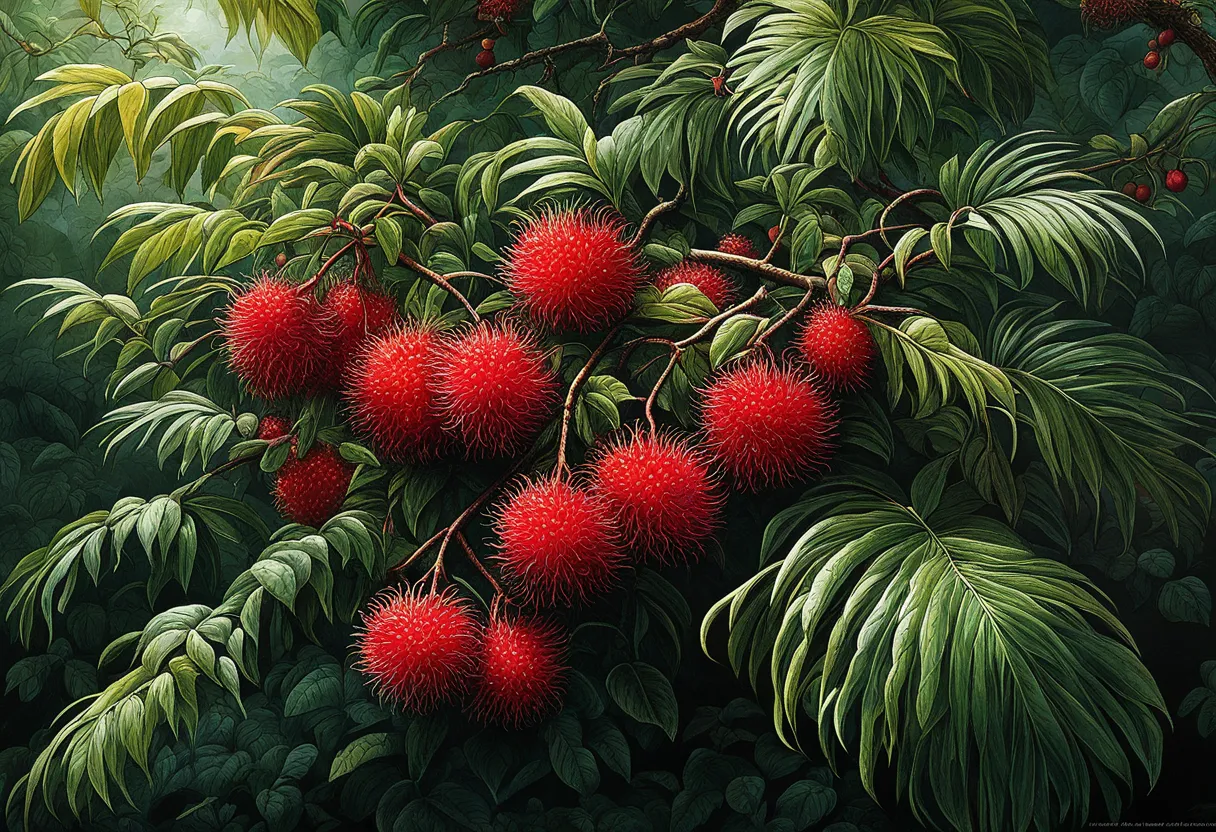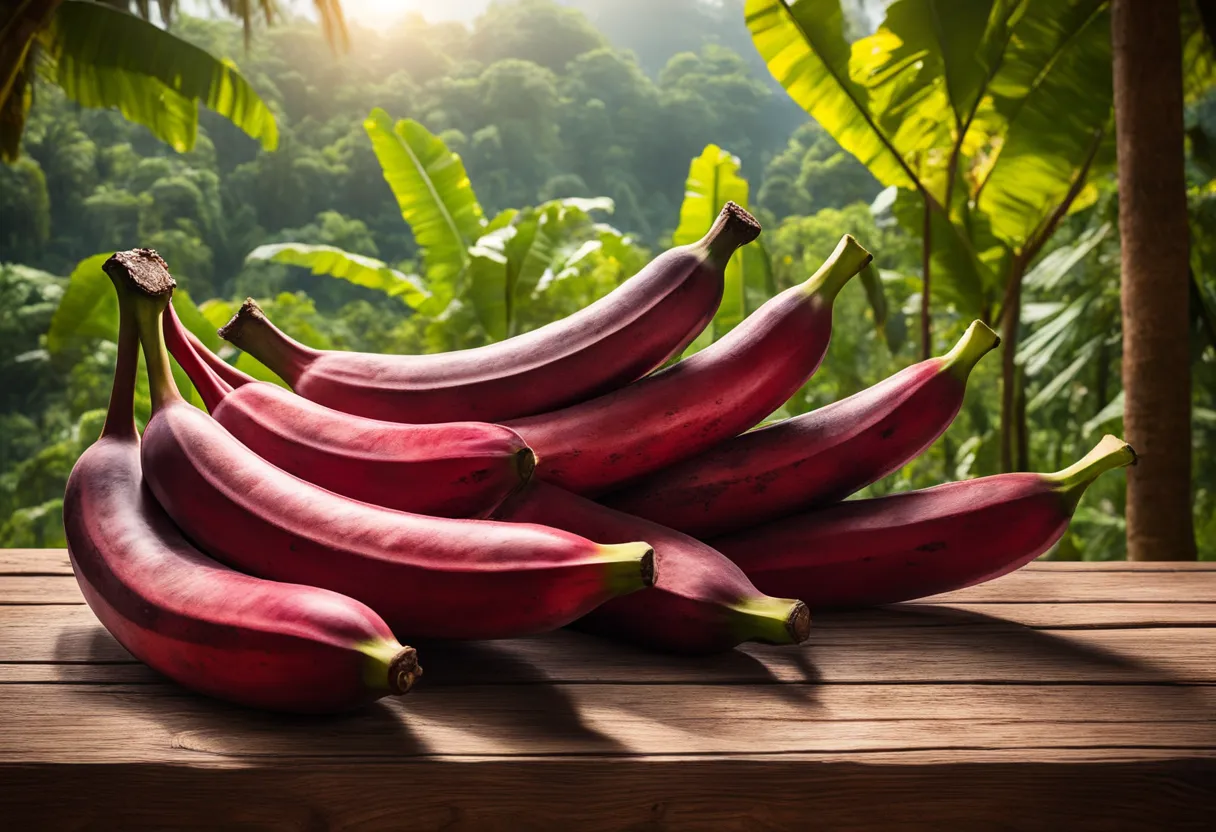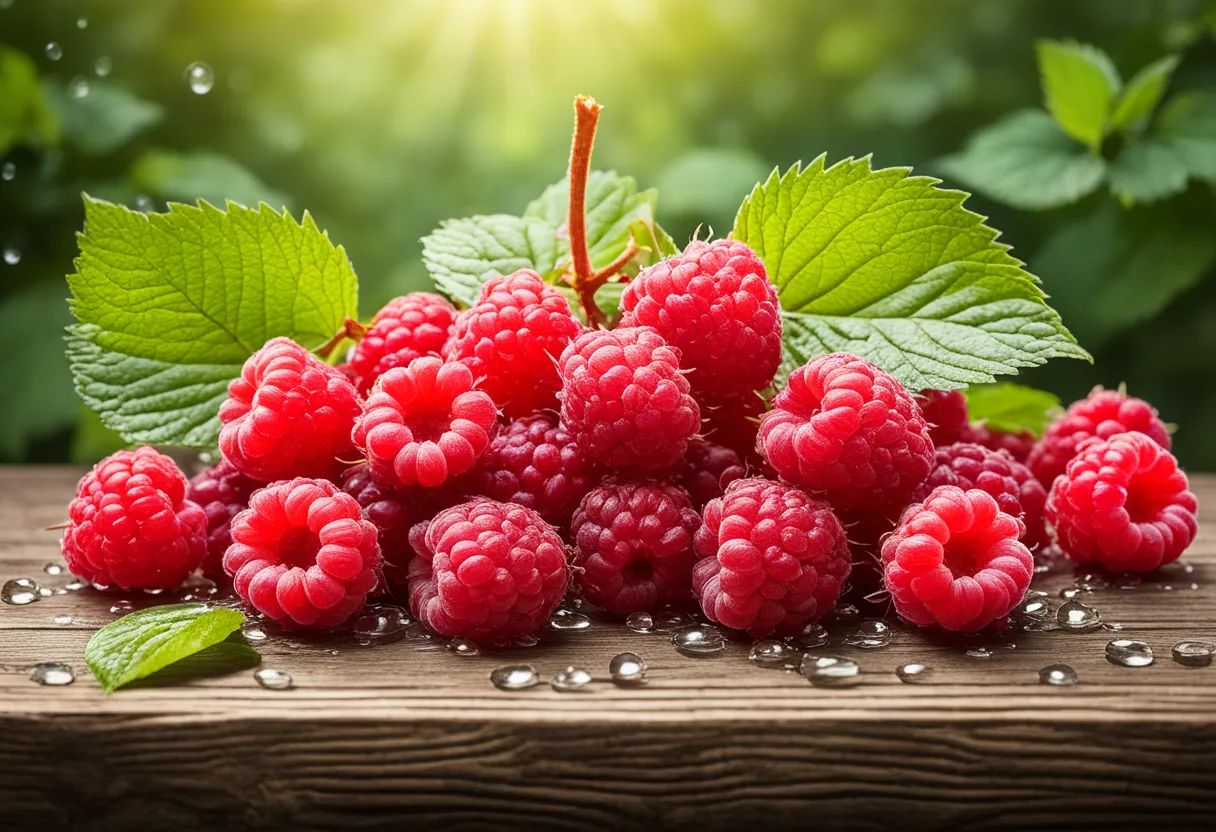Are you ready to embark on a tantalizing journey through the world of fruits starting with “R”? From the juicy burst of raspberries to the exotic sweetness of rambutan, each fruit brings its own explosion of flavor, nutritional benefits, and culinary versatility. Let’s explore these delightful offerings and perhaps discover some new favorites along the way!
Raspberries are not just a feast for the eyes with their vibrant color; they’re also a powerhouse of nutrients. These juicy, small fruits are known for their sweet-tart flavor that can brighten up any dish. Packed with vitamins, fiber, and antioxidants, raspberries are a fantastic choice for a healthy snack or a colorful addition to desserts and salads. Did you know that raspberries can also be a great ally in your fitness journey? Yes, their high fiber content helps in weight management!
Ever seen a fruit that looks like it could double as a small, exotic pet? Meet the Rambutan. This tropical fruit, with its hairy exterior, might seem intimidating at first, but it’s all sweetness on the inside. Similar to lychee in taste, rambutan offers a juicy, sweet experience that’s also rich in vitamin C and minerals. It’s a burst of tropical sunshine in every bite, perfect for refreshing your palate on a hot day or adding a twist to your fruit salads.
Often caught in an identity crisis, Rhubarb is technically a vegetable, but let’s be honest, we all love it in our sweet dishes. With its tart, refreshing flavor, rhubarb is a staple in pies and desserts. Beyond its unique taste, rhubarb is also a great source of vitamins, adding not just flavor but also a nutritional boost to your meals. So, next time you’re thinking of dessert, why not consider a strawberry-rhubarb pie? It’s a classic combo for a reason!
Think bananas are all yellow? Think again! Red bananas are here to surprise you with their sweeter, creamier taste compared to their yellow counterparts. These vibrant fruits are not just a treat to your taste buds but also to your health, offering a boost of beta-carotene and vitamin C. Whether you’re enjoying them raw, blended into smoothies, or baked into desserts, red bananas are sure to add an exciting twist to your fruit intake.
Last but not least, let’s talk about the Rose Apple. Contrary to what its name might suggest, it’s not related to roses or apples. This fruit boasts a crisp texture and a sweet flavor that makes it a refreshing treat, especially in tropical regions. Rose apples are perfect for snacking, adding to fruit salads, or even juicing. So, if you’re looking to add some exotic flair to your fruit repertoire, the rose apple is definitely worth a try.
In conclusion, fruits starting with “R” offer a rich tapestry of flavors and nutritional benefits. From the tangy sweetness of raspberries to the exotic appeal of rambutan, there’s a whole world of delicious options to explore. So why not add some of these fruits to your next shopping list and surprise your taste buds with something new and exciting?
Raspberry
Raspberries might just be the showstoppers of the fruit world, don’t you think? Their vibrant color alone is enough to make a statement, but it’s their sweet-tart flavor that truly sets them apart. These juicy, small fruits are not just a feast for the eyes; they’re packed with nutritional benefits that make them a must-have in your diet. From vitamins to fiber and antioxidants, raspberries offer a powerful punch of health benefits.
But how can you enjoy raspberries, you ask? Let me count the ways! Whether you’re tossing them in a smoothie, sprinkling them on top of your morning oatmeal, or just snacking on them by the handful, raspberries are versatile and delicious. And let’s not forget about raspberry jam—a classic favorite that never goes out of style.
Here’s a quick rundown of why raspberries are so good for you:
- Rich in Vitamins: Raspberries are an excellent source of Vitamin C and manganese, making them great for your immune system and bone health.
- High in Antioxidants: These little fruits are loaded with antioxidants, which help fight off free radicals and reduce inflammation.
- Fiber-Filled: Raspberries are high in fiber, which is beneficial for digestive health and can help you feel full longer.
And if you’re feeling adventurous, why not try incorporating raspberries into your cooking? They make a stunning addition to salads, desserts, and even savory dishes. The explosion of flavor they bring to any meal is truly surprising!
In conclusion, raspberries are not just a treat for the taste buds; they’re a powerhouse of nutrition and versatility in the kitchen. So next time you’re at the grocery store, make sure to grab a pint (or two!) of these delightful fruits. Your body (and your palate) will thank you!

Rambutan
Rambutan, a gem hiding in the lush tropics, is as intriguing as its name suggests. Picture this: a fruit so vibrant and quirky, covered in hair, that it could easily be mistaken for a small sea creature rather than something edible. But don’t let its peculiar exterior fool you. Beneath that hairy facade lies a juicy, sweet treasure that’s not only a delight to the taste buds but also a powerhouse of nutrients.
Native to Southeast Asia, rambutan is often likened to lychee and longan, thanks to its translucent, juicy flesh and sweet flavor. However, rambutan stands out with its unique appearance and distinct taste. Peeling the rambutan might seem like a task, but the effort is well rewarded with the taste of its succulent flesh that’s both sweet and slightly acidic, a true tropical surprise!
But it’s not just about the taste. Rambutan packs a nutritional punch, too. Here’s a quick rundown of what these little balls of joy bring to the table:
- Vitamin C: A champion for your immune system, helping you fend off colds and infections.
- Minerals: Loaded with iron, calcium, and phosphorus, rambutan aids in strengthening bones and boosting overall health.
- Fiber: Great for digestion, making rambutan not just a treat for your taste buds but also your gut.
- Antioxidants: These help in fighting free radicals, protecting your body from oxidative stress and inflammation.
Not only is rambutan a feast for your senses and a boon for your health, but it’s also versatile in the culinary world. Whether eaten fresh, tossed into a vibrant salad, mixed into a cocktail, or used as a topping for desserts, rambutan adds a splash of color and a burst of flavor that’s hard to forget.
So, the next time you’re in the mood for something exotic, why not give rambutan a try? It’s a small, hairy package full of surprises, ready to explode with flavor and nutrition in every bite. Trust me, your taste buds (and body) will thank you!
Rhubarb
might just be one of the most intriguing plants out there. Often mistaken for a fruit because of its use in sweet pies and desserts, rhubarb is actually a vegetable. It’s known for its long, crimson stalks, which are the only edible part of the plant – remember, the leaves are toxic! But let’s not dwell on the danger; instead, let’s dive into the explosion of flavor and benefits this plant offers.
First off, the taste of rhubarb is unmistakably tart, with a hint of sweetness that comes alive when cooked. Its unique flavor makes it a favorite for jams, jellies, and especially pies, earning it the affectionate nickname, “the pie plant.” But rhubarb’s appeal isn’t just taste deep. This plant is a powerhouse of nutrients, packed with vitamin K, which supports bone health, and vitamin C, an essential antioxidant for your immune system. Plus, it’s a great source of fiber, aiding in digestion.
For those looking to incorporate rhubarb into their diet, here’s a quick guide on how to prepare it:
- Wash and Trim: Start by washing the stalks thoroughly and trimming off any leaves (remember, they’re toxic!).
- Cut: Slice the stalks into manageable pieces – typically about 1/2 inch thick.
- Cook: Rhubarb can be tough, so it’s usually cooked. You can stew it with a little water and sweetener of your choice until it breaks down into a delicious compote.
- Enjoy: Use your cooked rhubarb in pies, tarts, or even over yogurt for a tangy treat.
Whether you’re a seasoned rhubarb lover or just curious about trying it, this vegetable offers a unique combination of tartness and sweetness that can add a surprise element to your dishes. Not to mention, its vibrant red color can make any dish visually stunning. So next time you’re at the market, don’t pass by the rhubarb. Embrace its bold flavor and nutritional benefits, and let it explode into your culinary adventures!

Red Banana
When we think of bananas, the classic yellow variety usually springs to mind. However, the is a fascinating alternative that’s ripe for exploration. Unlike their yellow cousins, red bananas are smaller, plumper, and, as the name suggests, possess a beautiful deep red or purple skin when ripe. But it’s not just their appearance that sets them apart. Red bananas have a sweeter and creamier taste, often described as having hints of raspberry in addition to the traditional banana flavor. This makes them a unique treat for the palate, as well as a conversation starter in the kitchen.
But the appeal of red bananas goes beyond taste. They are nutritional powerhouses, packed with essential vitamins and minerals. The rich color of their skin is due to the presence of beta-carotene, an important antioxidant that the body converts into vitamin A, crucial for eye health, skin health, and immune function. Additionally, red bananas are a good source of vitamin C, fiber, and potassium, making them an excellent choice for anyone looking to boost their nutritional intake.
From a culinary perspective, red bananas are incredibly versatile. They can be eaten raw, added to smoothies for a tropical twist, or used in baking to create moist and flavorful cakes and bread. Their sweet taste also makes them a perfect pairing for yogurt or oatmeal, providing a natural sweetness without the need for added sugars.
- Nutritional Benefits: High in beta-carotene, vitamin C, fiber, and potassium.
- Culinary Uses: Versatile in use, from smoothies to baking.
- Taste Profile: Sweeter and creamier than yellow bananas, with hints of raspberry.
In conclusion, red bananas offer a delightful surprise for those accustomed to the more common yellow variety. With their unique taste, nutritional benefits, and culinary versatility, they are definitely worth seeking out. Whether you’re looking to add a pop of color to your fruit bowl or wanting to experiment with new flavors in your cooking, red bananas are sure to make a lasting impression.
Rose Apple
When you hear , your mind might immediately wander to a fusion of roses and apples, but this unique fruit stands in a category of its own. Native to the Southeast Asian region, the Rose Apple bears no direct relation to the common apples or roses we’re familiar with. Instead, it offers a crisp texture and a sweet, slightly floral flavor that can be a delightful surprise to the palate. Imagine biting into a fruit that tastes like a refreshing blend of rose water and apple—this is what makes the Rose Apple a tropical treasure.
Not only is the Rose Apple a treat for the taste buds, but it’s also packed with nutritional benefits. Rich in vitamin C, dietary fiber, and antioxidants, it contributes to healthy skin, aids in digestion, and helps in fighting off free radicals. What’s more, its high water content makes it an excellent choice for staying hydrated in hot climates.
But how do you enjoy this exotic fruit? Here are a few suggestions:
- Eaten raw: After washing the fruit, it can be consumed directly, skin and all, or sliced into salads for a refreshing crunch.
- Juiced: For a hydrating drink, juicing the Rose Apple can be a fantastic way to enjoy its sweet flavor.
- Pickled or preserved: In some cultures, Rose Apples are pickled or made into jams and jellies, which serve as a delightful spread on bread or crackers.
In conclusion, the Rose Apple is a fruit that not only tantalizes the taste buds with its unique flavor but also offers a range of health benefits. Whether you’re enjoying it raw, in a juice, or as part of a culinary creation, the Rose Apple is sure to add an explosion of flavor and nutrition to your diet.





